London 2012: Athletes' Village tests its readiness ahead of the Games
- Published
After covering four previous Olympic and three Commonwealth Games, you might have thought you'd seen it all, but my overnight stay in the Athletes' Village was a first.
Normally by the time we arrive in a country for a Games, the Village is already in lockdown. Security is a huge priority and media are only allowed into what's known as the international area of the Village.
That's usually a small, restricted space, usually well away from the accommodation, where we can carry out pre-arranged interviews with athletes and coaches.
The Village is normally their domain, but just for a few hours, it was claimed by around 1,000 interlopers: sports administrators, sponsors, representatives of the London boroughs, and the international media.
We were in fact their guinea-pigs, in a mass shakedown to test out the readiness of the Village services and their ability to cope with a big crowd.
With 16,000 athletes and coaches expected to come through the Village during the course of the Games, they're going to need to be ready, as that's a number to match the population of a small town.
First impressions are of the inevitable bureaucracy that goes with processing so many new arrivals. Accreditations have to be checked, bags searched.
Instructions were to bring no liquids greater than 100ml, much like airport security in the UK, and hand luggage only.
Athletes however are allowed four kit bags, and looking at the amount of official clothing the GB team are being given, they're going to need the full allowance.
After swapping passports for room keys, we were allowed to cross the threshold. I hadn't seen the Village properly since its concrete shell days and there's been a huge transformation.
Covering 36 hectares, there are 2,818 apartments in 11 separate plots.
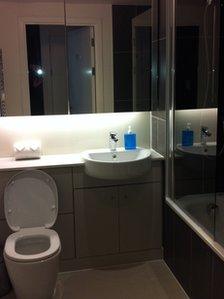
"The best bits are the bathrooms," inside an Olympic Village apartment
There's more than a quarter of a million cubic metres of accommodation, ranging from one bedroom apartments, to four and five bed townhouses. After the Games, they will be converted into residential accommodation.
As they'll be used for the Paralympians as well, accessibility has been designed in, and the legacy use was also part of the planning.
There's a coherence about the way the buildings flow, they're individually designed, and a long way from the grey uniform tower blocks I've come across elsewhere.
Portland and Cotswold stone colours mix with more industrial concrete greys and darker tones, broken up in places by wooden accents and dotted with many balconies - some in opaque green and others in clear glass.
Sculptures stand among the green spaces where the landscaping has bedded in well, helped no doubt by the miserable weather so no risk of under-watering whatsoever.
Pavements are a mixture of resin bonded aggregates, sandstone flags and more conventional paving. It's all a good mix, nothing offends really.
Whether any of this matters a lot to the athletes I'm not sure, but it'll certainly help the resale after the Games.
Once inside my apartment for the night, it's clear that again, thought has been given to the longer term use of these properties. The best bits are the bathrooms, which of course will stay unchanged in legacy.
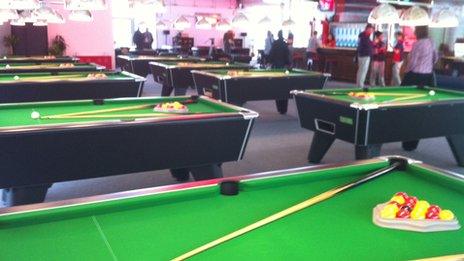
Ten pool tables line up side by side in the Globe
They're solidly built and of decent quality, unlike it must be said some of the occasional furniture in there.
The bedside cabinets and coffee tables are both inoffensive and insubstantial in their laminated particle board construction.
The minute someone stands on one to change a light bulb, it will be heading for the skip. The beds are also from the budget end of the spectrum, but the mattresses seemed comfortable enough and the Olympic-themed bedding appropriate.
I had no hot water in my apartment, 23B on floor 7 of the Heritage 1 block, but that's because no-one told me to put on the immersion heater.
The foam block loungers with their turquoise blue fabric covers are comfortable enough, as are the funky green beanbags, which I reckon will be the most popular for flopping on.
The television with its Freeview set-up was fine, and there are more power sockets and internet points than you can shake a stick at. It's basic but it works.
Kitchens will be retro-fitted, which will make space tight in there. I had a balcony, kitted out with cafe chairs and table, plus a decent view back towards the Olympic Stadium. Athletes should feel connected with the Olympic Park, as around almost every corner there's a venue view, mainly the Basketball Arena and Velodrome.
Athletes don't need kitchens as 24 hours a day, they have food on tap, in the main dining area.
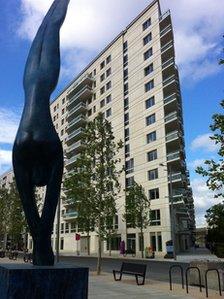
Sculptures stand among the green spaces where the landscaping has bedded in well
The vastness of the place makes you stop in your tracks as you walk though the entrance. A sea of blue-backed chairs takes the eye towards the centre of the venue and the Best of British food area.
There are rows of serving counters under colourful signs proclaiming a commonwealth of catering such as Indian, African and Caribbean, halal, Mediterranean, kosher - it's all there, and you can eat underneath the arches, if you get my drift, of the main fast food sponsor.
Games organisers Locog say the menu has been developed in consultation with dieticians and sport nutritionists, although portion size is clearly a matter of personal choice. I had some slightly overcooked roast beef and Yorkshire pudding, and a bit of salmon fillet, also on the dry side.
It was canteen rather than cuisine, but when you are trying to cook for up to 5,000 people at once, the hand-crafted touch rather goes out of the window.
The important thing is it tasted okay, and let's be honest athletes tend to look at food as refuelling as much as anything. The queue to get served progressed quickly enough and the staff were great.
Weather permitting, there will be an outdoor street food area doing barbecues which I think will go down well. The drizzle and blustery winds meant we weren't given that option.
In total, the organisers say they'll serve 1.2 million meals throughout the Games, it's literally like feeding an army.
Every general knows the troops need their rest and relaxation, and that's taken care of as well.
It will be competitive to just get a game on one of the 10 pool tables that line up side by side in the Globe, the social hub of the village, with its soft drinks only bar, DJ sounds and relaxed surroundings.
Pink neon signs with Boogie and WOW messages are perhaps trying too hard, but the vibe is contemporary retro with leather sofas and chairs, rugs and standard lamps mixed with glass and chrome.
It'll be busy in there, and if your apartment backs onto the plaza, it might be a bit on the raucous side.
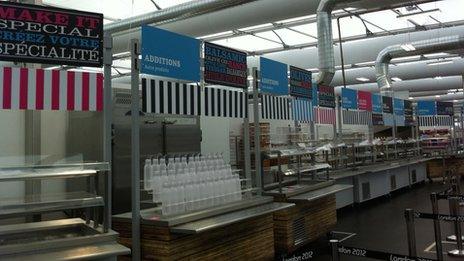
Rows of serving counters under colourful signs proclaim a commonwealth of catering
Athletes are reminded about their conduct in the village, and the need to respect the need for peace and quiet for those waiting for their competitions to start, but inevitably there's a clash of cultures with those de-mob happy once their events are over.
Probably the most striking building architecturally with its cheese wedge angles is the polyclinic.
The medical centre is kitted out with the best diagnostic equipment available, including MRI scanners, to help it with the core task of treating sports injuries.
There are physiotherapists, podiatrists, osteopaths and dentists, so muscles, bones and teeth are well covered, and they anticipate treating up to 200 people a day.
It will be open from 07:00 BST until 23:00 BST with an on-call service available overnight. After the Games it will be handed over to the NHS to serve the local community.
Permanent residents will also have the facility of a brand new school on their doorstep with places for 1,800 children aged 4-19, specialising in the performing arts.
That's the future planned for the Village Service Centre.
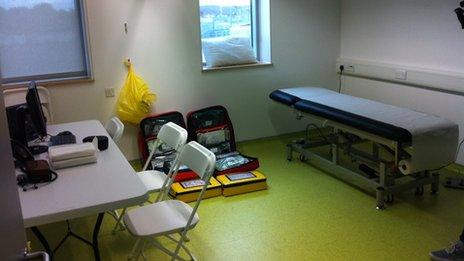
The medical centre is kitted out with the best diagnostic equipment available including MRI scanners
At the Games, it'll be the logistics and transport HQ, and house 12,000 square metres of gym, with 750 pieces of equipment and a team of 100 personal trainers.
It will also be the multi-faith centre for the Games, with Christianity, Judaism, Islam, Hinduism and Buddhism represented.
Whilst I was there, a three piece band was playing which will be one of several buskers who will be helping add to the atmosphere of the village, popping up to play impromptu gigs.
The organisers have consulted widely among the groups who will be using the Village, to try to get the details right, and that seems to be paying off.
The former athletes milling around on open night were genuinely impressed, and it's their opinion that surely carries the most weight.
As for my night's sleep, well, the blackout curtains helped, the door slamming down the corridor at 03:00 didn't, and neither did the text message from the Royal Mail at 07:07 telling me my Olympic tickets would be delivered that day.
An appropriate alarm call, somehow. I left pondering who might be next in room 23B and feeling just a little more connected to the Games than before.